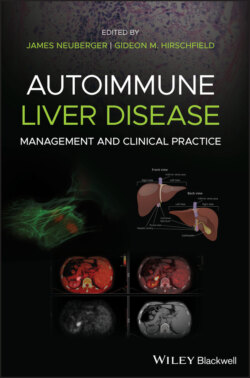Читать книгу Autoimmune Liver Disease - Группа авторов - Страница 48
Role of the Liver as an Adaptive Immune Organ
ОглавлениеIn addition to the innate immune functions, the liver has important roles in adaptive immunity [6]. The normal liver is a distinct “lymphoid” compartment containing CD8 αβ T cells, activated CD4 and CD8 T cells, γδT cells, memory T cells and B cells. Indeed, the proportions of highly activated T cells in the liver exceed those in blood. In contrast, normal liver contains scant numbers of naive T cells and B cells.
Most often, antigen‐activated DCs migrate to local lymph nodes to activate non‐hepatic T cells, which subsequently circulate and enter tissues through transendothelial migration. However, hepatic DCs, LSECs, and HSCs also function as APCs for intrahepatic T‐cell activation of adaptive immunity. Hepatocytes and cholangiocytes may also serve as APCs after cytokine stimulation. CD4 T cells activated by hepatic APCs primarily differentiate into Th2 cells, secreting immunosuppressive IL‐10 and IL‐4. Frequently, CD8 T cells activated in the liver have functional deficiencies leading to premature apoptosis. However, LSECs can directly activate functional antigen‐specific CD8 CTLs in the liver by cross‐presentation of soluble exogenous antigens in class I HLA molecules.
Hepatic Kupffer cells regulate T‐cell homeostasis by inducing apoptosis of senescent T cells expressing CD95 (Fas), TNF‐apoptosis‐inducing ligand (TRAIL), and programmed cell death 1 (PD‐1) receptors. Furthermore, binding of Kupffer cell PD‐L1 to PD‐1 expressed by activated CD4 T cells induces immunosuppressive IL‐10 and reduces apoptosis of CD4 T regulatory cells (Tregs).
Mucosal invariant T (MAIT) cells have characteristics of both innate and adaptive immune cells that are relevant in AILDs [7]. MAIT cells have invariant TCR α‐chains that respond to bacterially processed vitamin B antigens presented by unique major histocompatibility complex (MHC) class I‐related molecules (MR‐1) on APCs. Normally found only in blood, gut mucosa and mesenteric lymph nodes, MAIT cells congregate in the portal tracts of patients with chronic liver diseases, including AIH, PBC, PSC, alcoholic and non‐alcoholic fatty liver diseases, and chronic hepatitis C virus (HCV) infection. Proinflammatory cytokines IL‐12 and IL‐18 activate MAIT cells to display dual characteristics of CD4 Th1 and Th17 cells by secreting interferon (IFN)‐γ, TNF‐α and IL‐17. Up to 25% express cytotoxic granzyme B, a feature of cytotoxic NK, NKT, and CD8 T cells. Importantly, MAIT cell cytokines stimulate cholangiocyte secretion of cytokines capable of transforming CD4 iTregs into proinflammatory CD4 Th17 cells (Figure 2.2).
